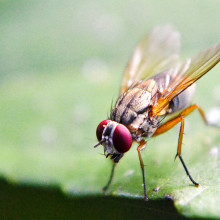Do insects have a stress response?
Charlie sent in this question "Humans have adrenaline for our fight or flight situation, do bugs have this too?" Eva Higginbotham put the question to insect-lover and expert, Eleanor Drinkwater from the University of York...
In this episode

00:00 - QotW: Do insects have a stress response?
QotW: Do insects have a stress response?
Eva - Thanks to the cooler weather here in the UK, the mosquitoes and flies that like to take up residence in my house each year have finally moved on, but I know one scientist who won’t be celebrating that fact - insect expert Eleanor Drinkwater, who answered Charlie’s question for us.
Eleanor - It's actually been suggested that this fight or flight stress response may have evolved really, really early in animal evolution. In fact, it could have evolved earlier than the split between animals, which have a backbone of vertebrates, and invertebrates, which means that we might expect to see certain similarities in stress responses between vertebrates and invertebrates. So in vertebrates, a signal from the brain in very simple terms, leads to a release of adrenaline, which in turn leads to a range of physiological changes preparing the animal for fight or flight.
Eva - Heart racing, rapid breathing, sweaty palms? All a normal response to stress in humans and caused by adrenaline. But what happens in invertebrates?
Eleanor - Well, first of all, we don't see adrenaline. But we do see other hormones which appear to perform a similar function. So in invertebrates, one of the key hormones for this is a hormone called Oktober mean. Now, this hormone is released in the invertebrate brain, as well into the hemolymph. So hemolymph is essentially an invertebrate equivalent of the bloodstream. So from the human limp, the Oktober mean affect a wide range of tissues, including things like the heart, the airbags, the sensory organs, and on top of this, it also causes a release of stored hormones, which lead to fat reserves being mobilized, allowing the invertebrates to prepare for rapid activity.
Eva - So there are remarkable similarities between how humans and invertebrates prepare their bodies for this fight or flight response. But some invertebrates do have some...creative defensive responses in their arsenal, too!
Eleanor - So one of my favorites, for example, is the small caterpillar. Now when they are alarmed, they will rear up lash with these amazing whips which come out of their tails, as well as even spraying formic acid. And which is just really remarkable, and something that you just wouldn't see in vertebrate systems. So even though you get these certain similarities in the kind of physiological preparation for fight or flight between vertebrates and invertebrates, invertebrates still have a lot of really fascinating and specific tricks up their sleeve.
Eva - Thanks Eleanor! Next week, we’ll be pondering over this question from Jo:
Jo - My question is about drinking water. We drink gallons of the stuff in a lifetime, but which is better for us, hard or soft?










Comments
Add a comment